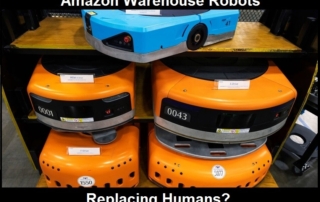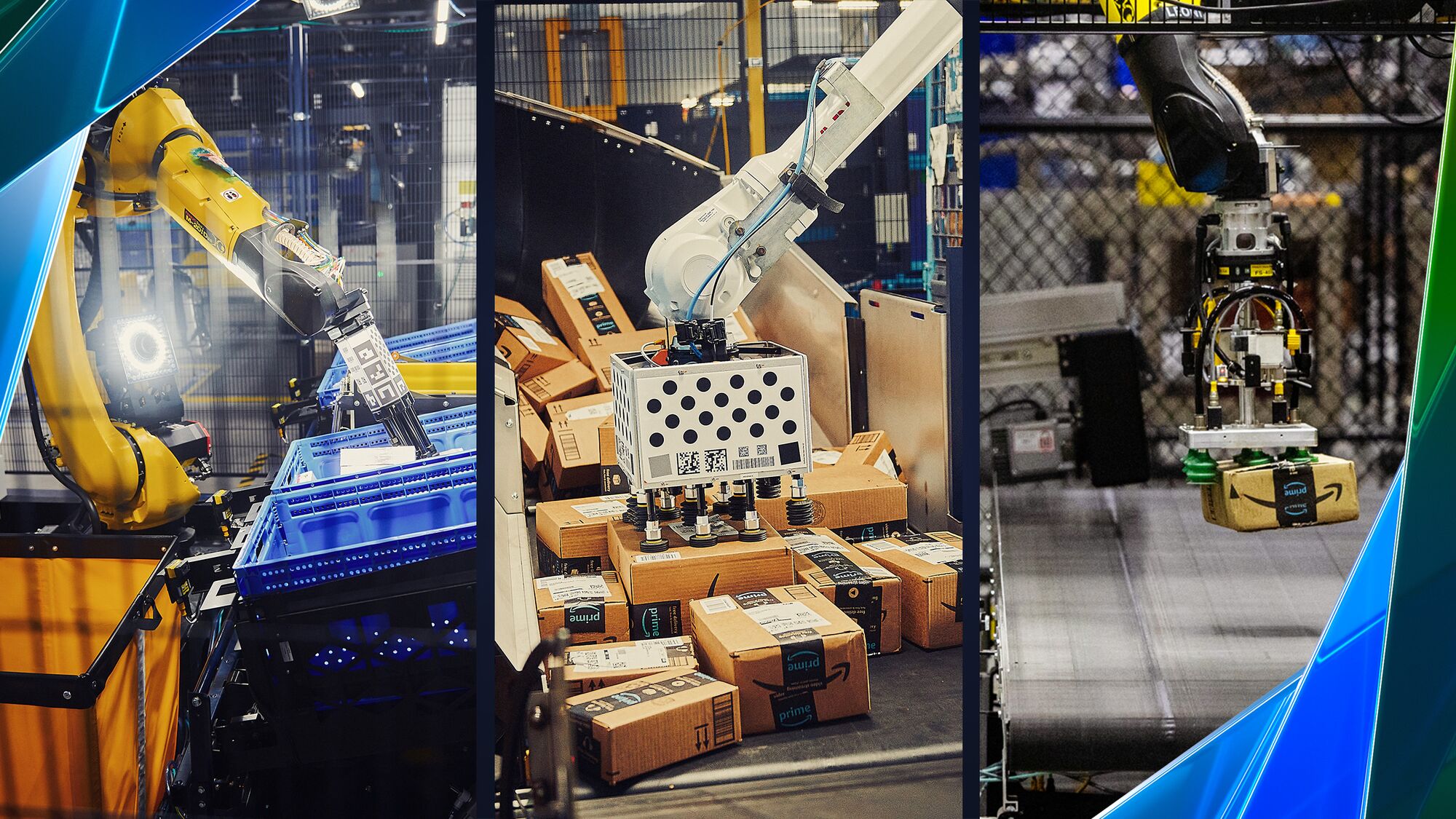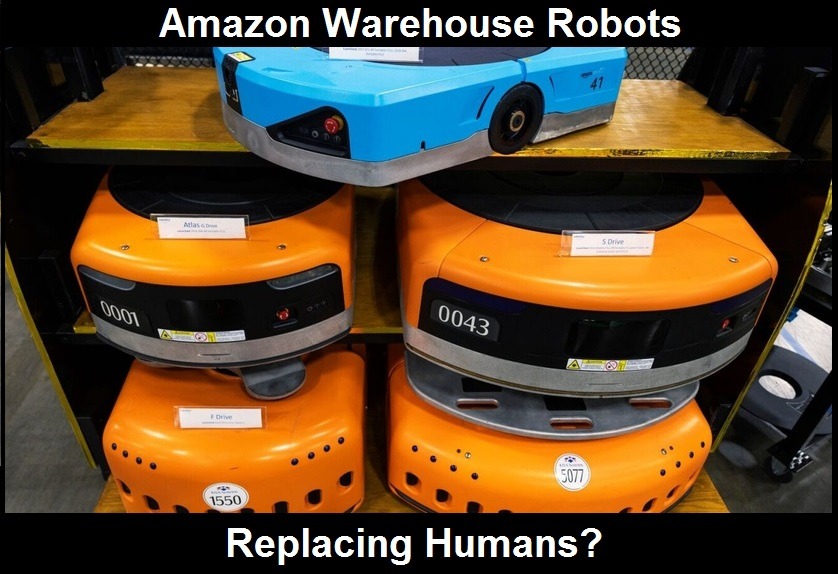
by Brian Shilhavy
Editor, Health Impact News
Amazon announced yesterday that they had added their “1 millionth robot” to their fulfillment centers. This announcement has led to another news frenzy about how robots are replacing humans.
And yet, there was nothing in Amazon’s announcement that predicted this. It was the Wall Street Journal’s (WSJ) coverage of the announcement that has been repeated and spread like wildfire through both the corporate and alternative media today.
This was the opening statement of the WSJ article:
The automation of Amazon.com facilities is approaching a new milestone: There will soon be as many robots as humans. (Source.)
While this statement was repeated far and wide to predict that robots were now taking over the labor market and replacing humans, other facts from this announcement by Amazon were completely ignored.
Tech Radar, a technology publication, had a much more balanced coverage of this announcement:
Amazon Robotics VP Scott Dresser boasted that more than 700,000 employees have been upskilled since 2019 through training in robotics, engineering and maintenance, suggesting that human roles at Amazon could be evolving rather than disappearing.
Dresser also noted that new fulfillment centers, including Shreveport, LA, require 30% more technical roles to look after the tech.
Even the WSJ mentioned this later in their article, and gave one example:
For some Amazon workers, the increasing automation has meant replacing menial, repetitive work lifting, pulling and sorting with more skilled assignments managing the machines.
“I thought I was going to be doing heavy lifting, I thought I was going to be walking like crazy,” said Neisha Cruz, who spent five years picking items at an Amazon warehouse in Windsor, Conn., before she was trained to oversee robotic systems.
Today she sits in front of a computer screen in a Tempe, Ariz., office making sure mobile robots inside Amazon facilities across the U.S. are working properly. She earns about 2.5 times more pay than she did when she started at Amazon.
“You have completely new jobs being created,” such as robot technicians, said Yesh Dattatreya, senior applied scientist at Amazon Robotics.
Warehouse workers are being trained in mechatronics and robotics apprenticeships. (Source.)
So if 1 million robots have now been added to Amazon warehouses worldwide, and over 700,000 hourly workers have retrained to operate this technology, what about the technology professionals who were hired from outside Amazon, such as engineers, tech managers, tech producers who develop and maintain the equipment, etc.?
That could easily make up a workforce of 1 million that offsets the 1 million robots, as Amazon admits that their fully automated warehouses require 30% MORE employees.
The other thing the people predicting the end of the human labor force in favor of robots are failing to leave out of their fear mongering reports, is a picture of what these robots in Amazon warehouses look like, which is similar to the “robots” that many consumers already have in their homes: vacuum cleaner “robots”.
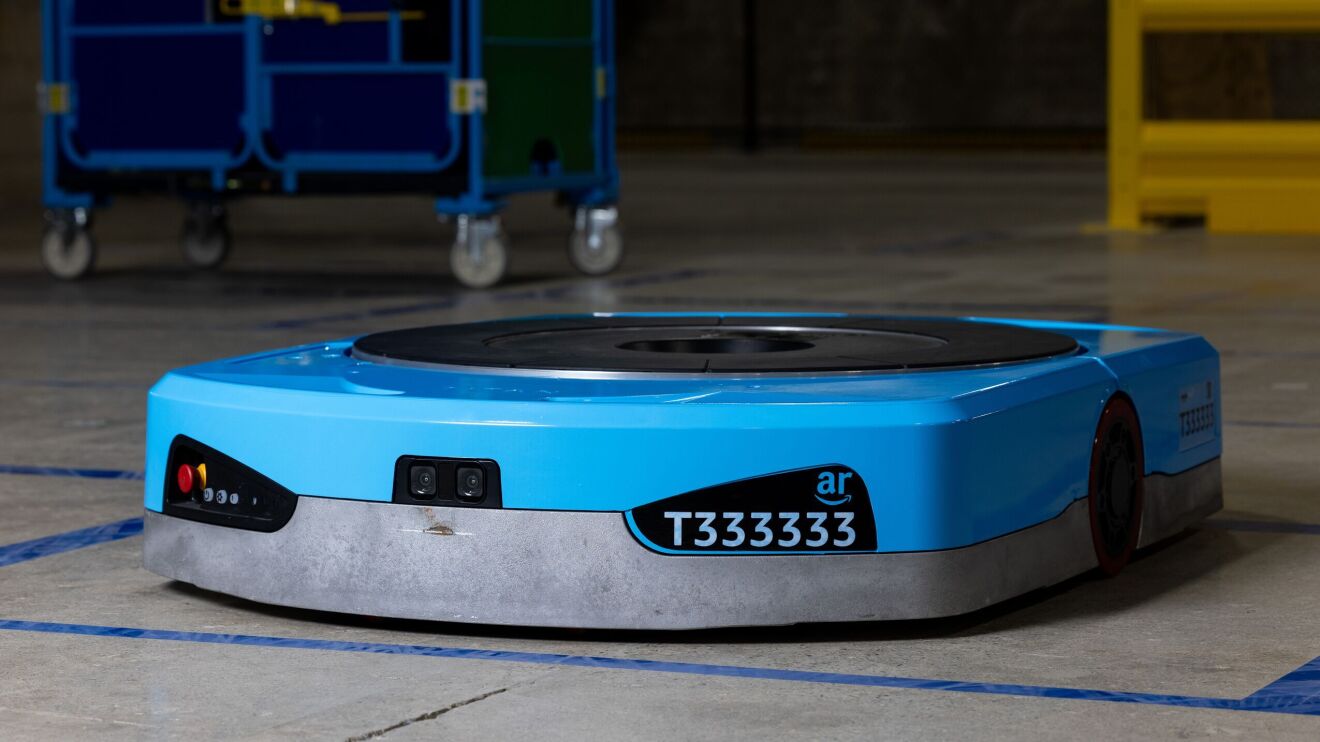
Amazon Titan warehouse robot. Image Source.
These apocalyptic articles make it sound that the robots in commercial use in Amazon warehouses are all humanoid robots with arms, legs, hands and feet.
Of course one can look up “amazon robots” online and see humanoid examples, but they are still prototypes not in production yet, and may never be.
From the WSJ article:
Amazon has been testing a humanoid robot, its manufacturer Agility Robotics said. The robots, which have legs, arms and a head and have been tested with tasks such as recycling containers at Amazon, are still in research and development, Amazon said.
Other than the Roomba-like warehouse robots, there are a few other types of robots Amazon uses that are like glorified forklifts with extensions like “arms” that can more efficiently move things through the warehouse, or grab and move something from point A to point B, and these are larger machines which would only have a few per warehouse.
You can see a list of warehouse robots that Amazon currently uses here.
Sorry, no humanoid robots!
The Problems and Limitations of Warehouse Automation that Nobody is Talking About
Warehouse automation with robotics has been around for almost 2 decades now, so let’s talk about some the limitations and dangers of relying too much on the technology.
First, they need electricity to operate, and when the grid goes down, humans can still work with backup battery-operated lights.
And while all of these warehouses for sure have back-up generators, have these warehouses been fully tested to see if those back-up generators will have enough power to do more than just turn the lights back on and get the Internet back up and running?
Those robots need a ton of power to operate, I would imagine. And especially with AI, new power centers are being built as rapidly as possible to meet the demand of new data centers.
It was reported earlier this week in Texas that a new law gives grid operators the power to disconnect these data centers during a crisis. See:
Texas law gives grid operator power to disconnect data centers during crisis
Another big concern to being so dependent on the technology is the SOFTWARE that is needed to run all of these robots.
As a former Certified Microsoft Systems Engineer, I can tell you that this is a much BIGGER danger to being dependent upon all of these robots.
Amazon calls its software “DeepFleet” and describes it like this:
“Think of DeepFleet as an intelligent traffic management system for a city filled with cars moving through congested streets. Just as a smart traffic system could reduce wait times and create better routes for drivers, DeepFleet coordinates our robots’ movements to optimize how they navigate our fulfillment centers.” (Source.)
How does one deploy this software and updates across the Amazon warehouses around the world running this software?
Through the Internet.
So first, the Internet has to be available at these warehouses, and secondly, that software can be hacked or have some bad code that could bring down everything.
And we saw how that worked last year when a single Microsoft Windows update was deployed to millions of MS Windows computers around the world, which caused worldwide chaos when it failed, even bringing down airports’ ability to show flight information. See:
One Single Computer Glitch Could Cost Tens of $Billions of Losses, Showing How Frail Technology Has Become
The other statistic I could not find, probably because Amazon.com will not reveal it publicly, is how accurate are these robots in terms of sending the right products that were ordered to the customer?
When I started my online ecommerce business back in 2002 and we experienced rapid growth, one problem we found was that the error rate in what is called “pick and pack” has to be very low when you are shipping a lot of products, or you will lose customers and revenue to those mistakes.
The industry standard for error rates back then was .5%, or 99.5% success rate and shipping out the correct order to the customer, which is one mistake for every 200 packages shipped.
We still maintain that standard today, with NO robots.
Amazon.com ships billions of orders a day, with some of them their own branded products, mostly made in China, and the others are products of third party vendors.
I don’t know what Amazon.com’s error rate is for shipping their own products with all of these robots, but for the orders they ship for other vendors, the rate is required to be below 1% to maintain their Amazon store, which is twice as high as the older standards, and the standard that my company still maintains, without robots.
We know that automation with robots in warehouses does not automatically mean that their pick and pack services increase in quality, because there are websites out there instructing companies how to setup their automation to make sure it works properly.
Here is one called “sortingrobotics.com”:
10 Common Mistakes in Pick and Pack Automation
Is this Technology even Profitable and Sustainable?
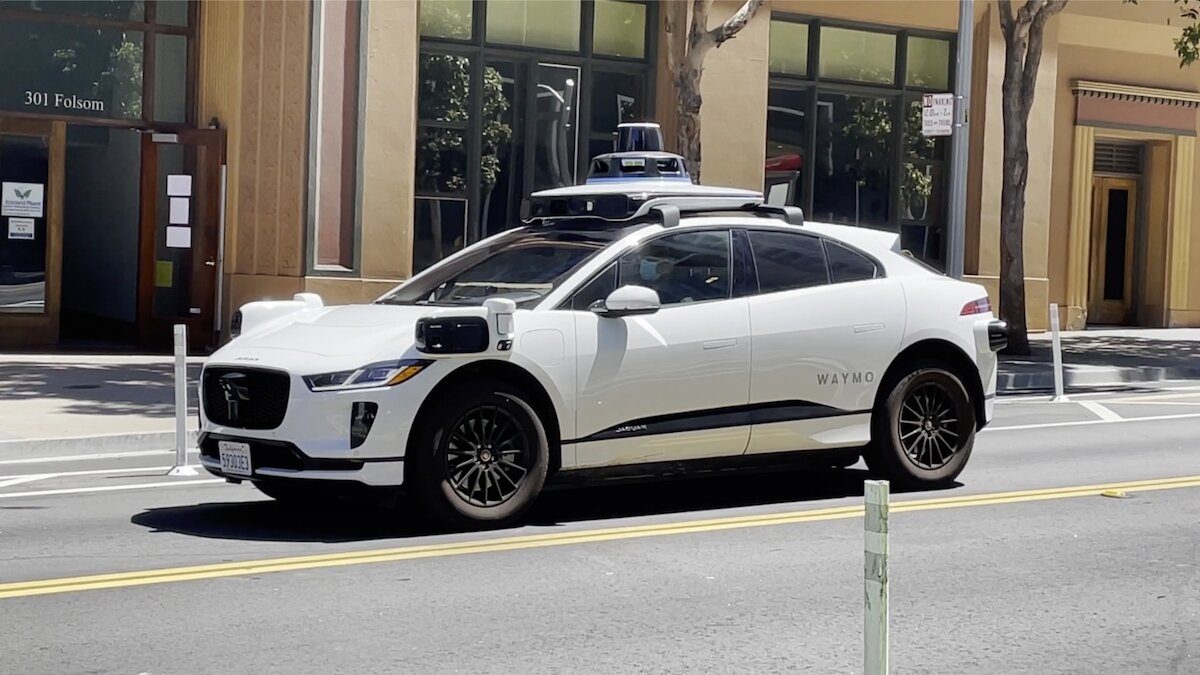
Google’s Waymo Robotaxi.
The last, and perhaps the most important question we should ask, would be: Is this technology even profitable?
No, it is not. The hope is that some day they can “scale” this to mass production and make it profitable.
I grew up with Amazon.com, and started my own ecommerce company just a few years later. Jeff Bezos has rich and powerful friends that allowed him to keep building up Amazon.com to become the most popular ecommerce site in the world, for over a decade without earning a profit.
He was gathering so many customers into his database that investors just assumed he would one day learn how to make it profitable, so they kept throwing $millions into the company to make it happen. It would be years later when Amazon Web Services began with their Cloud computing division when they finally started earning a profit.
We can be sure that the same thing is happening today with Amazon’s robotics division.
As an example, we can look at Google’s Waymo robotaxis, which have been in development for about two decades now, and started with funding from the U.S. Government through the Defense Advanced Research Projects Agency (DARPA).
There have been talks for a couple of years now that Google’s parent company, Alphabet, is going to spin off Waymo as a separate company and do an IPO.
But based on reported financial reports for Waymo, it is believed that it is still losing almost $1 billion every single quarter. And yet, they are the “gold standard” for robotaxis, having the most cars on the road. They do a couple of hundred thousand ride shares a week, while Uber, which is run by human drivers, does 15 million ride shares a day.
Tesla just released their own robotaxis in Austin, Texas, but it is only a few cars on a closed course, with a human driver in the passenger seat. And yet, they are considered the main competitor to Waymo.
While many of these driverless taxi companies are no longer revealing how many humans it takes to operate one “driverless” automobile, it has been previously published that in some of these companies it takes about 1.5 humans behind the scenes to keep these “driverless” cars operating.
With Google’s Waymo, considered the gold standard with the most cars deployed, they still can NOT go to the airport or on freeways, as it is too difficult for them. And they have been working on this technology for almost two decades.
It was also just announced a few days ago that Waymo “quietly” just shut down its Detroit plant.
Self-driving car company Waymo quietly closed its Detroit plant.
Google-affiliated autonomous vehicle company Waymo shuttered its plant in Detroit earlier this year after shifting resources and production down south.
The developer of self-driving shuttle technology, along with its automotive supplier partner Magna, ceased operations at a factory leased from American Axle & Manufacturing Inc. in the first quarter, Waymo spokesman Chris Bonelli confirmed to Automotive News affiliate Crain’s Detroit Business.
The closure marks a quiet ending to a ballyhooed project announced in 2019 as the “world’s first 100% dedicated Level 4 autonomous vehicle factory.” The 200,000-square-foot plant, expected to create as many as 400 engineering jobs, was seen as a major victory in Michigan’s quest to be a next-generation mobility hub.
The project never met those ambitious goals. At its peak, there were 60 employees who were on Magna’s payroll doing contract work for Waymo, Magna spokesman Dave Niemiec said. (Full article.)
The fact is that Silicon Valley still has too much money to throw away on science fiction, and they can continue to develop it whether consumers want it or not.
Robots can NOT replace humans. They can make humans more efficient, but humans are still needed to run them.
America’s over-reliance on the technology will be her downfall, and perhaps we are already watching it happen.
The Pentagon’s budget has increased significantly the past few years to invest in Big Tech and AI. The Biden/Harris administration’s FY 2025 defense budget asked for close to $100 billion invested in technology like AI (source), and the new Trump administration is asking for even more (source.)
Did we just observe in real time how this worked out in the REAL world during the 12-day war against Iran? The U.S. and Israel were forced to end the war after only 12 days, as they ran out of bombs.
Iran, on the other hand, stated that they only used 5% of their missiles.
So what does Iran have that the U.S. doesn’t? Human labor, factories, and the ability to make LOTS OF BOMBS.
The U.S. and Israel thought they could rely on their technology to use espionage and terrorism to kill Iran’s top military leaders, hoping to cripple its military.
It didn’t, as Iran recovered quickly, and showed superior hardware made by human labor in factories that probably had ZERO robots working in them.
While people are saying, “There is peace and security,” then sudden destruction will come upon them as labor pains come upon a pregnant woman, and they will not escape. (1 Thessalonians 5:3)
Comment on this article at HealthImpactNews.com.
This article was written by Human Superior Intelligence (HSI)
See Also:
Understand the Times We are Currently Living Through
Exposing the Christian Zionism Cult
Christian Teaching on Sex and Marriage vs. The Actual Biblical Teaching
Where is Your Citizenship Registered?
The Bewitching of America with the Evil Eye and the Mark of the Beast
Jesus Christ’s Opposition to the Jewish State: Lessons for Today
Distinguishing True Prophets from False Prophets in These Evil Modern Times
Insider Exposes Freemasonry as the World’s Oldest Secret Religion and the Luciferian Plans for The New World Order

Identifying the Luciferian Globalists Implementing the New World Order – Who are the “Jews”?
The Brain Myth: Your Intellect and Thoughts Originate in Your Heart, Not Your Brain
Fact Check: “Christianity” and the Christian Religion is NOT Found in the Bible – The Person Jesus Christ Is
The Seal and Mark of God is Far More Important than the “Mark of the Beast” – Are You Prepared for What’s Coming?
The Satanic Roots to Modern Medicine – The Mark of the Beast?
Medicine: Idolatry in the Twenty First Century – 8-Year-Old Article More Relevant Today than the Day it was Written
Having problems receiving our emails? See:
How to Beat Internet Censorship and Create Your Own Newsfeed
We Are Now on Telegram. Video channels at Bitchute, and Odysee.
If our website is seized and shut down, find us on Telegram, as well as Bitchute and Odysee for further instructions about where to find us.
If you use the TOR Onion browser, here are the links and corresponding URLs to use in the TOR browser to find us on the Dark Web: Health Impact News, Vaccine Impact, Medical Kidnap, Created4Health, CoconutOil.com.
The post Is Amazon Really Eliminating Human Jobs with Robots? first appeared on Vaccine Impact.
Click this link for the original source of this article.
Author: AdminM
This content is courtesy of, and owned and copyrighted by, https://vaccineimpact.com and its author. This content is made available by use of the public RSS feed offered by the host site and is used for educational purposes only. If you are the author or represent the host site and would like this content removed now and in the future, please contact USSANews.com using the email address in the Contact page found in the website menu.

